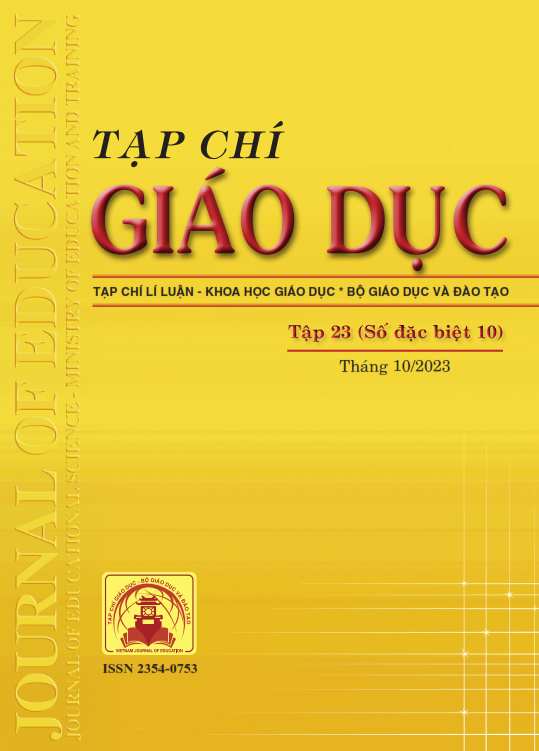Tác động của phương pháp đọc suy luận lên kĩ năng đọc hiểu tiếng anh của sinh viên Trường Đại học Công nghệ Đồng Nai
Tóm tắt
Currently, teaching inferential reading comprehension skills is viewed as one of the effective methods to enhance the reading comprehension competences of students studying English at universities in Vietnam. Many previous studies in this area have focused on classifying inference types. However, there has been limited research examining the impact of learning inferential reading comprehension skills on developing this competence for students studying English. There is a need for the application inferential reading comprehension skills for students at Dong Nai Technology University to boost the effectiveness of teaching these skills to them. This study demonstrates that the method of teaching inferential reading comprehension significantly improves the reading comprehension skills of these English learners. This article will help students enhance their inferential reading comprehension skills at intermediate and higher levels through engaging students in reading and developing their deeper inferential comprehension skills across various disciplines. Simultaneously, this article also assists instructors in gaining a better understanding of the students studying English at Dong Nai Technology University.
Tài liệu tham khảo
Allington, R. L. (1983). Fluency: The neglected reading goal. The Reading Teacher, 36(6), 556-561.
Anderson, R. C., & Pearson, P. D. (1984). A schema-theoretic view of basic processes in reading comprehension. In P. D. Pearson (Ed.), Handbook of reading research (pp. 255-291). New York: Longman.
Bobkina, J., & Stefanova, S. (2016). Literature and critical literacy pedagogy in the EFL classroom: Towards a model of teaching critical thinking skills. Studies in Second Language Learning and Teaching, 6(4), 677-696. https://doi.org/10.14746/ssllt.2016.6.4.6
Carrell, P. L., & Eisterhold, J. C. (1983). Schema theory and ESL reading pedagogy. TESOL Quarterly, 17(4), 553-573. https://doi.org/10.2307/3586613
Carver, R. P. (1992). Reading rate: Theory, research, and practical implications. Journal of Reading, 36(2), 84-95.
Fajardo, M. F. (2015). A review of critical literacy beliefs and practices of English language learners and teachers. University of Wollongong. University of Sydney Papers in TESOL, 10, 29-56.
Grabe, W. (2009). Reading in a second language: moving from theory to practice. Cambridge University Press.
Hiebert, E. H., & Fisher, C. W. (2005). A review of the National Reading Panel’s studies on fluency: The role of text. The Elementary School Journal, 105(5), 443-460. https://doi.org/10.1086/431888
Koda, K. (2007). Reading and language learning: Crosslinguistic constraints on second language reading development. Language Learning, 57, 1-44. https://doi.org/10.1111/0023-8333.101997010-i1
Macalister, J. (2008). Effect of a speed reading course in an English as a second language environment. TESOLANZ Journal, 16, 23-32.
Marzano, R. (2010). Teaching inference. Educational Leadership, 67(7), 80-81.
Millett, S. (2005a). New Zealand speed readings for ESL learners (Book One). Wellington, NZ: School of Linguistics and Applied Language Studies, Victoria University of Wellington.
Millett, S. (2005b). New Zealand speed readings for ESL learners (Book Two). Wellington, NZ: School of Linguistics and Applied Language Studies, Victoria University of Wellington.
Millett, S., Quinn, E., & Nation, P. (2007). Asian and Pacific speed readings for ESL learners. Wellington: English Language Institute Occasional Publication.
Nuttall, C. (1982). Teaching reading skills in a foreign language. London: Heinemann Educational Books.
Paris, S.G., & Stahl, S.A. (2005). Children's reading comprehension and assessment. Routledge.
Sheu, S. P. H. (2003). Extensive reading with EFL learners at beginning level. TESL Reporter, 36, 8-26.
Trần Khánh Đức (2021). Tư duy và phát triển tư duy kĩ thuật - công nghệ. Tạp chí Giáo dục, 513, 1-8.
Wolfe-Quintero, K., Inagaki, S., & Kim, H. Y. (1998). Second language development in writing: Measures of fluency, accuracy, and complexity. University of Hawaii: Second Language Teaching and Curriculum Center.
Đã Xuất bản
Cách trích dẫn
Số
Chuyên mục
Giấy phép

Tác phẩm này được cấp phép theo Ghi nhận tác giả của Creative Commons Giấy phép quốc tế 4.0 .












